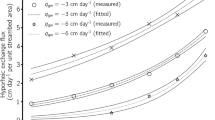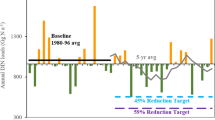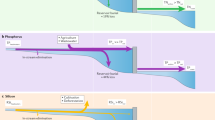Abstract
Increasing nitrogen concentrations in the world’s major rivers have led to over-fertilization of sensitive downstream waters1,2,3,4. Flow through channel bed and bank sediments acts to remove riverine nitrogen through microbe-mediated denitrification reactions5,6,7,8,9,10. However, little is understood about where in the channel network this biophysical process is most efficient, why certain channels are more effective nitrogen reactors, and how management practices can enhance the removal of nitrogen in regions where water circulates through sediment and mixes with groundwater—hyporheic zones8,11,12. Here we present numerical simulations of hyporheic flow and denitrification throughout the Mississippi River network using a hydrogeomorphic model. We find that vertical exchange with sediments beneath the riverbed in hyporheic zones, driven by submerged bedforms, has denitrification potential that far exceeds lateral hyporheic exchange with sediments alongside river channels, driven by river bars and meandering banks. We propose that geomorphic differences along river corridors can explain why denitrification efficiency varies between basins in the Mississippi River network. Our findings suggest that promoting the development of permeable bedforms at the streambed—and thus vertical hyporheic exchange—would be more effective at enhancing river denitrification in large river basins than promoting lateral exchange through induced channel meandering.
This is a preview of subscription content, access via your institution
Access options
Subscribe to this journal
Receive 12 print issues and online access
$259.00 per year
only $21.58 per issue
Buy this article
- Purchase on Springer Link
- Instant access to full article PDF
Prices may be subject to local taxes which are calculated during checkout



Similar content being viewed by others
References
McIsaac, G. F., David, M. B., Gertner, G. Z. & Goolsby, D. A. Eutrophication: Nitrate flux in the Mississippi River. Nature 414, 166–167 (2001).
Rabalais, N. N., Turner, R. E. & Wiseman, W. J. Gulf of Mexico Hypoxia A.K.A. ‘The Dead Zone’. Annu. Rev. Ecol. Syst. 33, 235–263 (2002).
Mulholland, P. et al. Stream denitrification across biomes and its response to anthropogenic nitrate loading. Nature 452, 202–205 (2008).
Woodward, G. et al. Continental-scale effects of nutrient pollution on stream ecosystem functioning. Science 336, 1438–1440 (2012).
Dahm, C., Grimm, N., Marmonier, P., Valett, H. & Vervier, P. Nutrient dynamics at the interface between surface waters and groundwaters. Freshwat. Biol. 40, 427–451 (2002).
Seitzinger, S. et al. Denitrification across landscapes and waterscapes: A synthesis. Ecol. Appl. 16, 2064–2090 (2006).
Burgin, A. J. & Hamilton, S. K. Have we overemphasized the role of denitrification in aquatic ecosystems? A review of nitrate removal pathways. Front. Ecol. Environ. 5, 89–96 (2007).
Battin, T. J. et al. Biophysical controls on organic carbon fluxes in fluvial networks. Nature Geosci. 1, 95–100 (2008).
Trimmer, M. et al. River bed carbon and nitrogen cycling: State of play and some new directions. Sci. Tot. Environ. 434, 143–158 (2012).
Findlay, S. Importance of surface–subsurface exchange in stream ecosystems: The hyporheic zone. Limnol. Oceanogr. 40, 159–164 (1995).
Helton, A. M. et al. Thinking outside the channel: Modeling nitrogen cycling in networked river ecosystems. Front. Ecol. Environ. 9, 229–238 (2010).
Boano, F. et al. Hyporheic flow and transport processes: Mechanisms, models, and biogeochemical implications. Rev. Geophys. 52, 2012RG000417 (2014).
Fischer, H., Kloep, F., Wilzcek, S. & Pusch, M. T. A river’s liver—microbial processes within the hyporheic zone of a large lowland river. Biogeochemistry 76, 349–371 (2005).
McClain, M. E. et al. Biogeochemical hot spots and hot moments at the interface of terrestrial and aquatic ecosystems. Ecosystems 6, 301–312 (2003).
Gandy, C., Smith, J. & Jarvis, A. Attenuation of mining-derived pollutants in the hyporheic zone: A review. Sci. Tot. Environ. 373, 435–446 (2007).
Harvey, J. W. & Fuller, C. C. Effect of enhanced manganese oxidation in the hyporheic zone on basin-scale geochemical mass balance. Wat. Resour. Res. 34, 623–636 (1998).
Böhlke, J. K. et al. Multi-scale measurements and modeling of denitrification in streams with varying flow and nitrate concentration in the upper Mississippi River basin, USA. Biogeochemistry 93, 117–141 (2009).
Ward, A. S. et al. Hydrologic and geomorphic controls on hyporheic exchange during base flow recession in a headwater mountain stream. Wat. Resour. Res. 48, W04513 (2012).
Kiel, B. A. & Cardenas, M. B. Lateral hyporheic exchange throughout the Mississippi River network. Nature Geosci. 7, 413–417 (2014).
Gomez-Velez, J. D. & Harvey, J. W. A hydrogeomorphic river network model predicts where and why hyporheic exchange is important in large basins. Geophys. Res. Lett. 41, 6403–6412 (2014).
Zarnetske, J. P., Haggerty, R., Wondzell, S. M. & Baker, M. A. Dynamics of nitrate production and removal as a function of residence time in the hyporheic zone. J. Geophys. Res. 116, G01025 (2011).
Harvey, J. W., Böhlke, J. K., Voytek, M. A., Scott, D. & Tobias, C. R. Hyporheic zone denitrification: Controls on effective reaction depth and contribution to whole-stream mass balance. Wat. Resour. Res. 49, 6298–6316 (2013).
Zarnetske, J. P., Haggerty, R., Wondzell, S. M., Bokil, V. A. & González-Pinzón, R. Coupled transport and reaction kinetics control the nitrate source-sink function of hyporheic zones. Wat. Resour. Res. 48, W11508 (2012).
Zarnetske, J. P., Haggerty, R., Wondzell, S. M. & Baker, M. A. Labile dissolved organic carbon supply limits hyporheic denitrification. J. Geophys. Res. 116, G04036 (2011).
Gomez, J. D., Wilson, J. L. & Cardenas, M. B. Residence time distributions in sinuosity-driven hyporheic zones and their biogeochemical effects. Wat. Resour. Res. 48, W09533 (2012).
Pinay, G., O’Keefe, T. C., Edwards, R. T. & Naiman, R. J. Nitrate removal in the hyporheic zone of a salmon river in Alaska. River Res. Appl. 25, 367–375 (2009).
Robertson, D. M., Schwarz, G. E., Saad, D. A. & Alexander, R. B. Incorporating uncertainty into the ranking of SPARROW model nutrient yields from Mississippi/Atchafalaya River basin watersheds. J. Am. Wat. Resour. Assoc. 45, 534–549 (2009).
Alexander, R. B., Smith, R. A. & Schwarz, G. E. Effect of stream channel size on the delivery of nitrogen to the Gulf of Mexico. Nature 403, 758–761 (2000).
Alexander, R. B. et al. Differences in phosphorus and nitrogen delivery to The Gulf of Mexico from the Mississippi River basin. Environ. Sci. Technol. 42, 822–830 (2008).
Hester, E. T. & Gooseff, M. N. in Stream Restoration in Dynamic Fluvial Systems: Scientific Approaches, Analyses, and Tools (eds Simon, A., Bennett, B. & Castro, J.) Vol. 194, 167–187 (American Geophysical Union, 2011).
Hynes, H. B. N. Groundwater and stream ecology. Hydrobiologia 100, 93–99 (1983).
Hakenkamp, C. C., Valett, H. M. & Boulton, A. J. Perspectives on the hyporheic zone: Integrating hydrology and biology. Concluding remarks. J. North Am. Benthol. Soc. 12, 94–99 (1993).
Scott, D. W. Multivariate Density Estimation: Theory, Practice, and Visualization (Wiley, 2015).
Robert, C. & Casella, G. Monte Carlo Statistical Methods (Springer, 2005).
Genz, A. Numerical computation of rectangular bivariate and trivariate normal and t probabilities. Stat. Comput. 14, 251–260 (2004).
Montgomery, D. R. & Buffington, J. M. Channel-reach morphology in mountain drainage basins. Geol. Soc. Am. Bull. 109, 596–611 (1997).
Buffington, J. M., Montgomery, D. R. & Greenberg, H. M. Basin-scale availability of salmonid spawning gravel as influenced by channel type and hydraulic roughness in mountain catchments. Can. J. Fish. Aquat. Sci. 61, 2085–2096 (2004).
Flores, A. N., Bledsoe, B. P., Cuhaciyan, C. O. & Wohl, E. E. Channel-reach morphology dependence on energy, scale, and hydroclimatic processes with implications for prediction using geospatial data. Wat. Resour. Res. 42, W06412 (2006).
Bridge, J. S. Rivers and Floodplains: Forms, Processes, and Sedimentary Record (Wiley, 2009).
Elliott, A. H. & Brooks, N. H. Transfer of nonsorbing solutes to a streambed with bed forms: Theory. Wat. Resour. Res. 33, 123–136 (1997).
Wörman, A., Packman, A. I., Marklund, L., Harvey, J. W. & Stone, S. H. Fractal topography and subsurface water flows from fluvial bedforms to the continental shield. Geophys. Res. Lett. 34, L07402 (2007).
Cardenas, M. B. A model for lateral hyporheic flow based on valley slope and channel sinuosity. Wat. Resour. Res. 45, W01501 (2009).
Bear, J. Dynamics of Fluids in Porous Media (American Elsevier Publishing, 1972).
Stonedahl, S. H., Harvey, J. W., Wörman, A., Salehin, M. & Packman, A. I. A multiscale model for integrating hyporheic exchange from ripples to meanders. Wat. Resour. Res. 46, W12539 (2010).
Stonedahl, S. H., Harvey, J. W., Detty, J., Aubeneau, A. & Packman, A. I. Physical controls and predictability of stream hyporheic flow evaluated with a multiscale model. Wat. Resour. Res. 48, W10513 (2012).
Stonedahl, S. H., Harvey, J. W. & Packman, A. I. Interactions between hyporheic flow produced by stream meanders, bars, and dunes. Wat. Resour. Res. 49, 5450–5461 (2013).
Vittal, N., Ranga Raju, K. G. & Garde, R. J. Resistance of two dimensional triangular roughness. J. Hydraul. Res. 15, 19–36 (1977).
Fehlman, H. M. Resistance Components and Velocity Distributions of Open Channel Flows Over Bedforms Master’s thesis, Colorado State Univ. (1985).
Shen, H., Fehlman, H. & Mendoza, C. Bed form resistances in open channel flows. J. Hydraul. Eng. 116, 799–815 (1990).
Wörman, A., Packman, A. I., Marklund, L., Harvey, J. W. & Stone, S. H. Exact three-dimensional spectral solution to surface–groundwater interactions with arbitrary surface topography. Geophys. Res. Lett. 33, L07402 (2006).
Boano, F., Revelli, R. & Ridolfi, L. Reduction of the hyporheic zone volume due to the stream-aquifer interaction. Geophys. Res. Lett. 35, L09401 (2008).
Boano, F., Revelli, R. & Ridolfi, L. Quantifying the impact of groundwater discharge on the surface–subsurface exchange. Hydrol. Process. 23, 2108–2116 (2009).
Zheng, C. & Bennett, G. D. Applied Contaminant Transport Modeling (Wiley-Interscience, 2002).
Seaber, P. R., Kapinos, F. P. & Knapp, G. L. Hydrologic Unit Maps: US Geological Survey 63 (US Geological Survey, 1987); http://pubs.usgs.gov/wsp/wsp2294/pdf/wsp_2294.pdf
Wolock, D. M. Hydrologic Landscape Regions of the United States (US Geological Survey, 2003); http://water.usgs.gov/GIS/metadata/usgswrd/XML/hlrus.xml#Metadata_Reference_Information
Wolock, D. M., Winter, T. C. & McMahon, G. Delineation and evaluation of hydrologic-landscape regions in the United States using geographic information system tools and multivariate statistical analyses. Environ. Manage. 34, S71–S88 (2004).
Wolock, D. M. Base-Flow Index Grid for the Conterminous United States (US Geological Survey, 2003); http://water.usgs.gov/lookup/getspatial?bfi48grd
National Rivers and Streams Assessment (2008–2009) 110 (US Environmental Protection Agency, 2013); http://water.epa.gov/type/rsl/monitoring/riverssurvey/upload/NRSA0809_Report_Final_508Compliant_130228.pdf
The Wadeable Streams Assessment: A Collaborative Survey of the Nation’s Streams 113 (US Environmental Protection Agency, 2006); http://water.epa.gov/type/rsl/monitoring/streamsurvey/upload/2007_5_16_streamsurvey_WSA_Assessment_May2007.pdf
Wilkerson, G. V. et al. Continental-scale relationship between bankfull width and drainage area for single-thread alluvial channels. Wat. Resour. Res. 50, 919–936 (2014).
Bieger, K., Rathjens, H., Allen, P. M. & Arnold, J. G. Development and evaluation of bankfull hydraulic geometry relationships for the physiographic regions of the United States. J. Am. Wat. Resour. Assoc. 51, 842–858 (2015).
Shepherd, R. G. Correlations of permeability and grain size. Ground Wat. 27, 633–638 (1989).
Lu, C., Chen, X., Cheng, C., Ou, G. & Shu, L. Horizontal hydraulic conductivity of shallow streambed sediments and comparison with the grain-size analysis results. Hydrol. Process. 26, 454–466 (2012).
Acknowledgements
This research was conducted while J.D.G.-V. held a postdoctoral associateship at the US Geological Survey. The work of J.W.H. and J.D.G.-V. is supported by USGS WAU and NWQP Programs and by the John Wesley Powell Center for Analysis and Synthesis: River corridor hot spots for biogeochemical processing—a continental-scale synthesis. M.B.C. is supported by a National Science Foundation CAREER grant (EAR-0955750). Any use of trade, firm, or product names is for descriptive purposes only and does not imply endorsement by the US Government.
Author information
Authors and Affiliations
Contributions
J.D.G.-V. and J.W.H. conceived the study and wrote the paper with contributions from M.B.C. and B.K. The data analysis, compilation and modelling were performed by J.D.G.-V. and B.K. All authors interpreted the results.
Corresponding author
Ethics declarations
Competing interests
The authors declare no competing financial interests.
Supplementary information
Supplementary Information
Supplementary Information (PDF 14077 kb)
Rights and permissions
About this article
Cite this article
Gomez-Velez, J., Harvey, J., Cardenas, M. et al. Denitrification in the Mississippi River network controlled by flow through river bedforms. Nature Geosci 8, 941–945 (2015). https://doi.org/10.1038/ngeo2567
Received:
Accepted:
Published:
Issue Date:
DOI: https://doi.org/10.1038/ngeo2567
This article is cited by
-
Climate and landform interact to control the source and transport of nitrate in Pacific Northwest rivers
Communications Earth & Environment (2024)
-
Superlinear scaling of riverine biogeochemical function with watershed size
Nature Communications (2022)
-
Environmental and anthropogenic factors affect bacterial community and nitrogen removal in the Yarlung Zangbo River
Environmental Science and Pollution Research (2022)
-
Isotopic signals in an agricultural watershed suggest denitrification is locally intensive in riparian areas but extensive in upland soils
Biogeochemistry (2022)
-
Preparing porous Cu/Pd electrode on nickel foam using hydrogen bubbles dynamic template for high-efficiency and high-stability removal of nitrate from water
Environmental Science and Pollution Research (2022)



